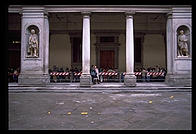
Museums
of Florence by Philip Greenspun; created 1995
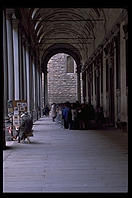 Here's
a museum where you can be worn out before you see even one picture. I happened by
at 8 am in December, an hour before the museum opened, and hundreds of Japanese
tourists already in line. In December. Imagine what the summer must be
like. I came back at 10 am and the line was still long. I came back at around 2
pm and there was no line, but to get to the first gallery one has to walk up a
five-story staircase.
Here's
a museum where you can be worn out before you see even one picture. I happened by
at 8 am in December, an hour before the museum opened, and hundreds of Japanese
tourists already in line. In December. Imagine what the summer must be
like. I came back at 10 am and the line was still long. I came back at around 2
pm and there was no line, but to get to the first gallery one has to walk up a
five-story staircase.
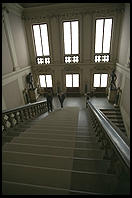
The Uffizi is probably the best collection of Renaissance art in the world. Florence is where the Renaissance started. The Uffizi was built as an office building for city administration, which from 1434 to 1743 meant the Medici family. The Medicis commissioned the best art of the Renaissance and make cameo appearances in a few paintings.
Connoisseurs love the Boticelli rooms, the portraits of Urbino, Michelangelo's
Holy Family; I like pictures with dragons in them. By far the best one in
the Uffizi is Cosimo's Perseus frees Adromeda. Not only is the dragon
rendered imaginatively but there is a tremendous amount of whimsy in the
painting, e.g., the figure of Mercury flying through the air.
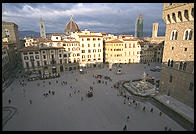
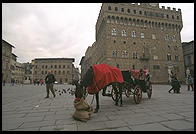 At the end of your visit, stop in the cafe and take a photo overlooking the
Piazza della Signoria. The edge where you need to stand is cordoned off but no
self-respecting Italian would let them stop him. I stepped over and squeezed off
a few frames; nobody hassled me.
At the end of your visit, stop in the cafe and take a photo overlooking the
Piazza della Signoria. The edge where you need to stand is cordoned off but no
self-respecting Italian would let them stop him. I stepped over and squeezed off
a few frames; nobody hassled me.
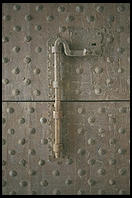 The town hall in 1255, a prison in the 16th century (complete with executions
until 1786), a museum since 1865, this is the place to learn just how violent the
Renaissance really was. The big draw at the Bargello is sculpture and the
sculpture generally depicts gratuitous violence. For example, there is a big
statue of Oceanus. Surrounding him with a few fish might have helped get the
point across, OK, but why is this guy actually stepping on a fish? I've seen
hundreds of depictions of Leda and the Swan (in which Zeus, who was generally
ready for action with anything, mortal or immortal, that wore a skirt, adopts the
guise of a swan and rapes the mortal Leda). Most of them are delicately
suggestive. Ammannati's sculpture in the Bargello is the only one I've seen in
which the swan is plainly "in there" (and kissing Leda on the lips to boot).
The town hall in 1255, a prison in the 16th century (complete with executions
until 1786), a museum since 1865, this is the place to learn just how violent the
Renaissance really was. The big draw at the Bargello is sculpture and the
sculpture generally depicts gratuitous violence. For example, there is a big
statue of Oceanus. Surrounding him with a few fish might have helped get the
point across, OK, but why is this guy actually stepping on a fish? I've seen
hundreds of depictions of Leda and the Swan (in which Zeus, who was generally
ready for action with anything, mortal or immortal, that wore a skirt, adopts the
guise of a swan and rapes the mortal Leda). Most of them are delicately
suggestive. Ammannati's sculpture in the Bargello is the only one I've seen in
which the swan is plainly "in there" (and kissing Leda on the lips to boot).
The museum is famous for its collections of Michelangelo and Donatello. It
might be a good place to take children because there is a big collection of armor
and weapons on the top floor.
Although there are two copies in public squares in Florence, everyone comes here to pay 12,000 lire to look at Michelangelo's original David. It really is magnificently displayed in the Accademia, which was started as an art school in 1563, allegedly the first in Europe. The collection displayed today was started in 1784 to provide examples for students. If the huge room on the second floor full of huge altarpieces doesn't convert you to Christianity, then you are probably beyond hope. It would probably be best to bone up on your New Testament before coming here if you want to understand the works, though the museum is sprouting superb explanatory signs, in Italian and English, in front of every item. Considering that most museums are sitting on $millions in property and often $billions in art treasures, you have to wonder why hardly any have hired a few graduate students to translate their explanations.
Everyone thinks this closes at 2 pm in the winter, but it doesn't anymore. It is open 9-7 every day except Monday and Sunday (when it is open 9-2). I'm told that there are huge lines to get in during the peak season.
Two centuries before Louis XIV started work at Versailles, Florentine banker Luca Pitti got into the business of building a really, really big house with a really, really big backyard. Pitti started in 1457 but by 1550 his family had gone bankrupt and the Medicis moved in. The Palatine Gallery is the best known part of this complex,with its huge royally-decorated rooms crammed with Renaissance and Baroque paintings. It is all very confusing because the pictures are left as the Medicis hung them, which was with an eye towards decoration not edification. The big names are all here even though some of the best stuff was carted across the river to the Uffizi.
There is the amusingly named "Galleria D'Arte Moderna" which contains works dating back to 1784 (a Roman friend of mine said she dated the "modern" period from 1600), a museum for the family's best furniture, pottery, silver, and other miscellaneous items, and a museum of costume. Frankly, I'd save my energy for the Boboli Gardens behind the Palazzo, constructed for the Medicis in 1549. I visited on a misty winter's day and found them enchanting, much more effective than I remembered from a bright September day years before.